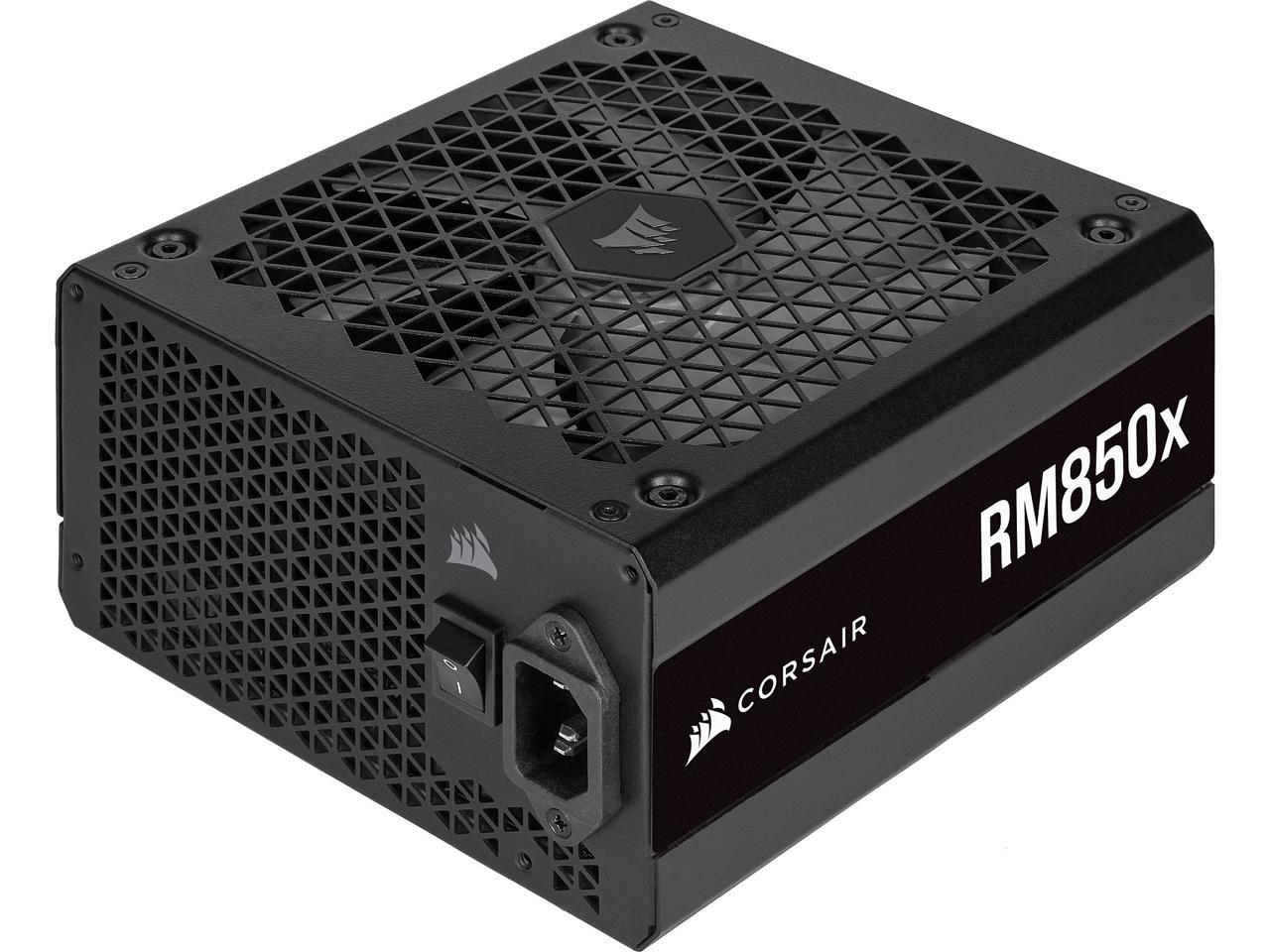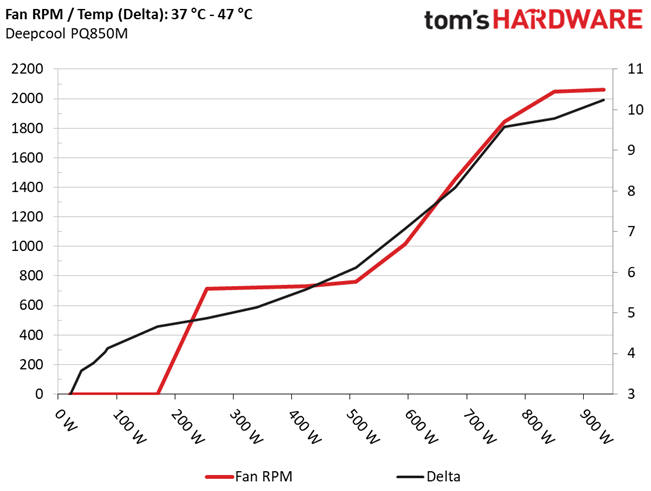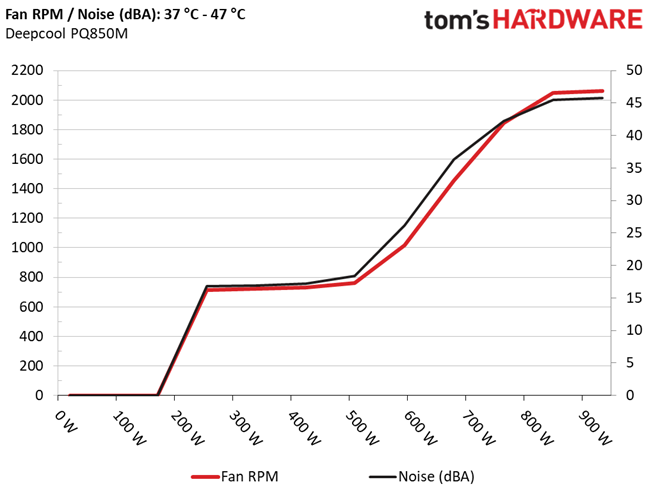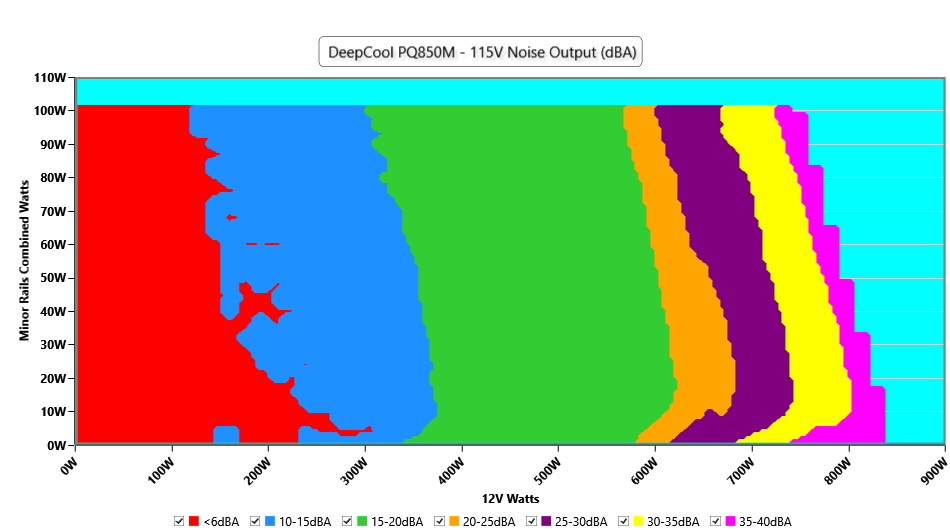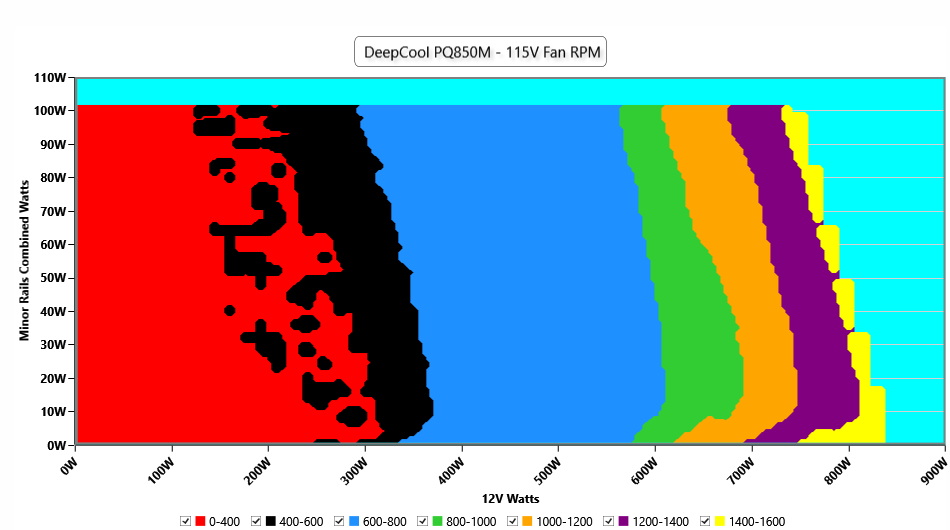Why you can trust Tom's Hardware
To learn more about our PSU tests and methodology, please check out How We Test Power Supply Units.
Primary Rails And 5VSB Load Regulation
The following charts show the main rails' voltage values recorded between a range of 40W up to the PSU's maximum specified load, along with the deviation (in percent). Tight regulation is an important consideration every time we review a power supply because it facilitates constant voltage levels despite varying loads. Tight load regulation also, among other factors, improves the system’s stability, especially under overclocked conditions and, at the same time, it applies less stress to the DC-DC converters that many system components utilize.
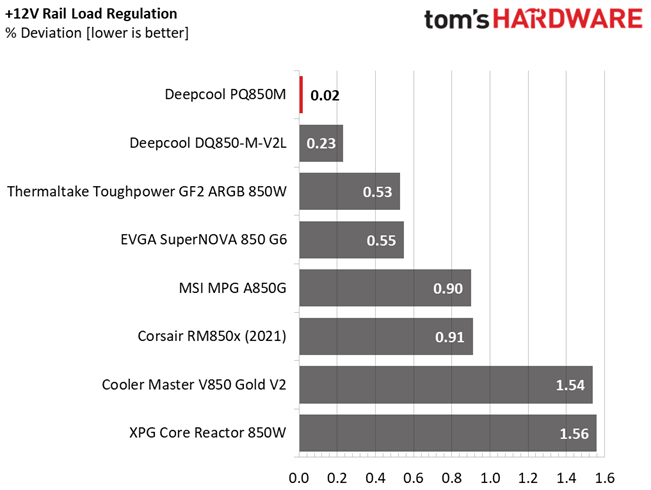
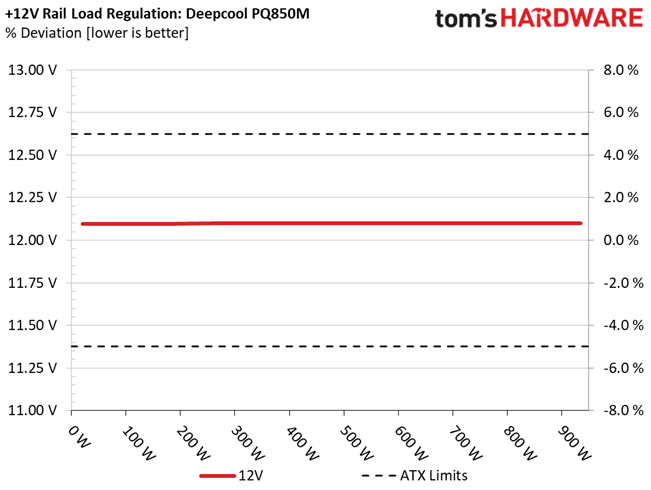
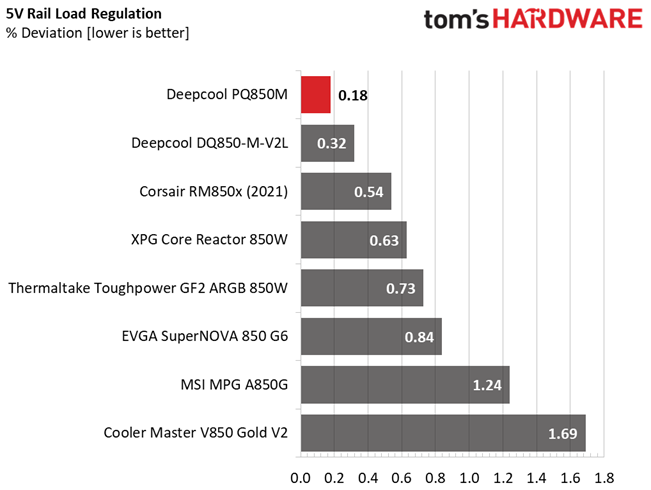
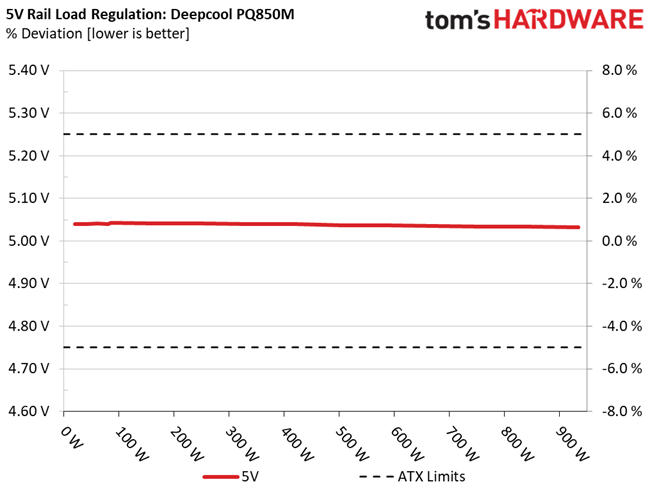
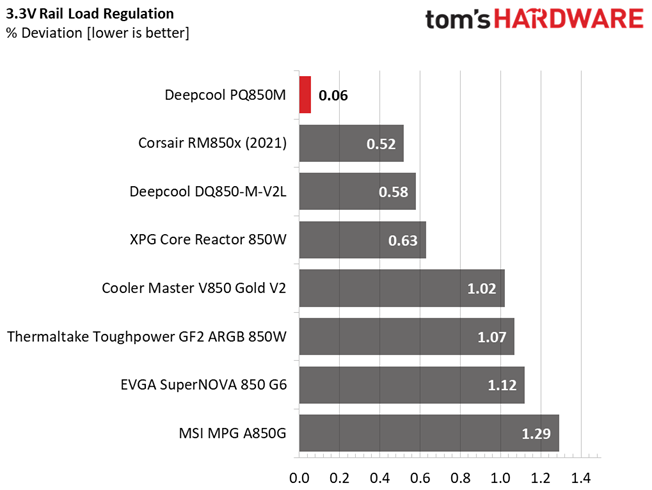

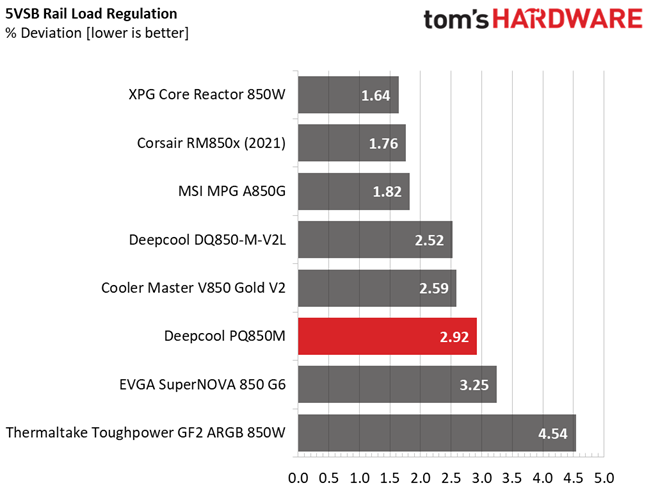
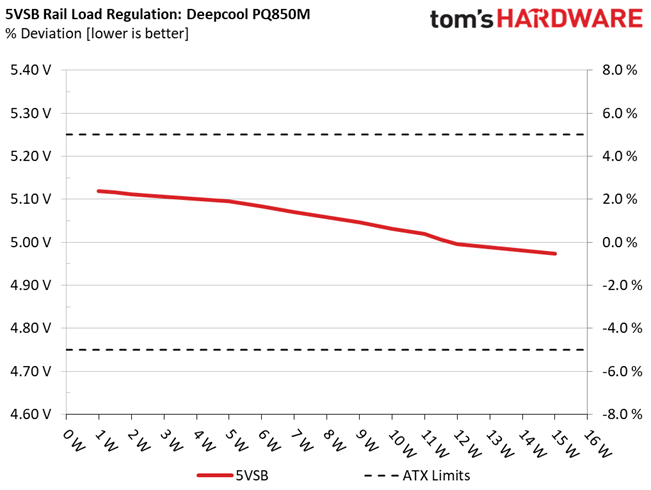
Load regulation is perfect on the main three rails and acceptable at 5VSB, where it doesn't matter much as long as this rail keeps its voltages within the specified range by the ATX spec.
Hold-Up Time
Put simply; hold-up time is the amount of time that the system can continue to run without shutting down or rebooting during a power interruption.
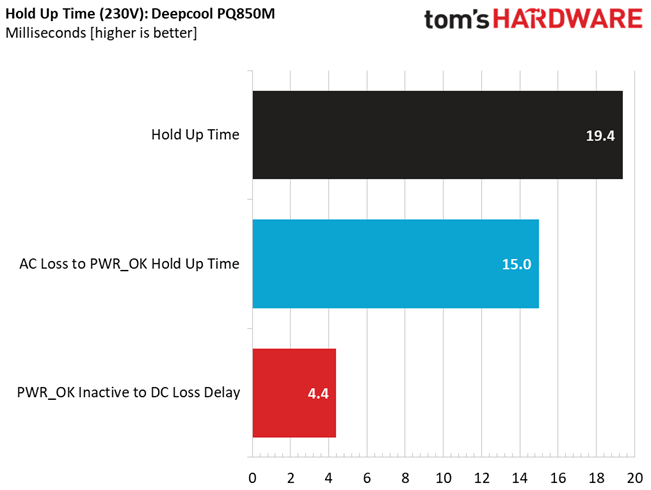
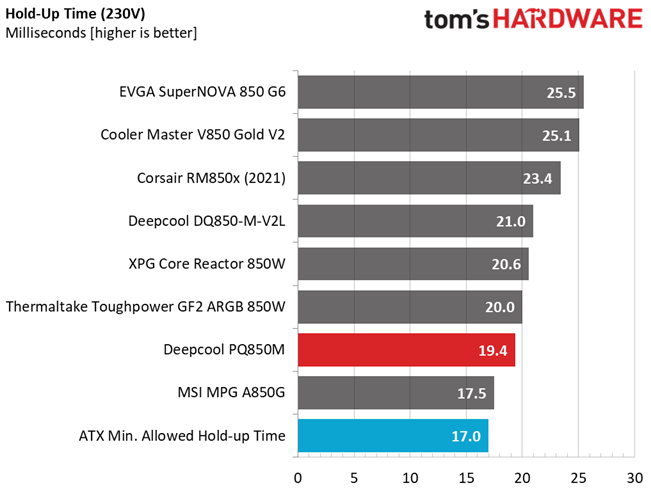
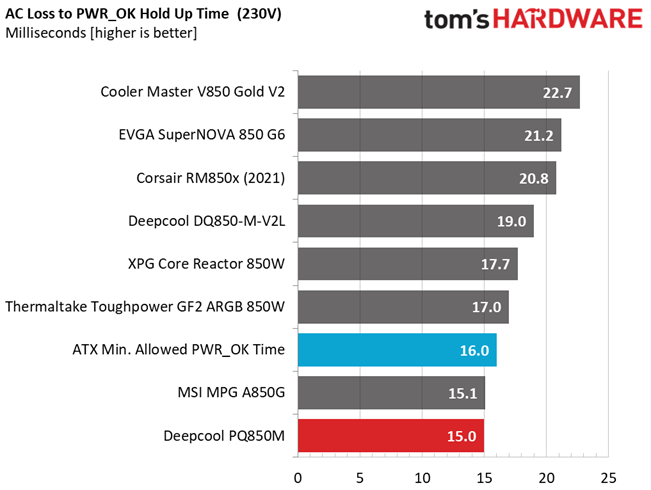
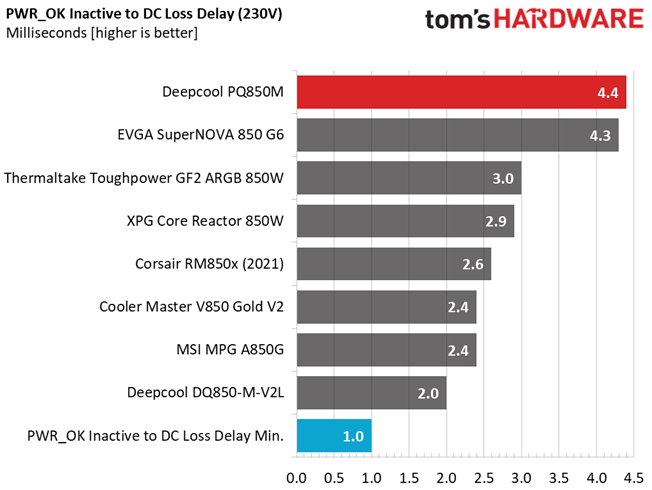
The hold-up time is longer than 17ms, but the power ok signal is lower than 16ms.
Inrush Current
Inrush current, or switch-on surge, refers to the maximum, instantaneous input current drawn by an electrical device when it is first turned on. A large enough inrush current can cause circuit breakers and fuses to trip. It can also damage switches, relays, and bridge rectifiers. As a result, the lower the inrush current of a PSU right as it is turned on, the better.


Inrush current is low with 115V but pretty high with 230V. A higher resistance NTC thermistor would help here.
Get Tom's Hardware's best news and in-depth reviews, straight to your inbox.
Leakage Current
In layman's terms, leakage current is the unwanted transfer of energy from one circuit to another. In power supplies, it is the current flowing from the primary side to the ground or the chassis, which in the majority of cases is connected to the ground. For measuring leakage current, we use a GW Instek GPT-9904 electrical safety tester instrument.
The leakage current test is conducted at 110% of the DUT's rated voltage input (so for a 230-240V device, we should conduct the test with 253-264V input). The maximum acceptable limit of a leakage current is 3.5 mA and it is defined by the IEC-60950-1 regulation, ensuring that the current is low and will not harm any person coming in contact with the power supply's chassis.
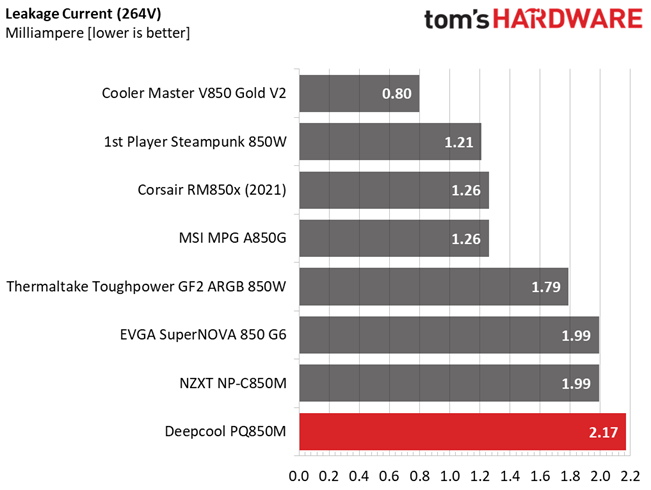
Leakage current is higher than competing offerings, but still lower than the limit.
10-110% Load Tests
These tests reveal the PSU's load regulation and efficiency levels under high ambient temperatures. They also show how the fan speed profile behaves under increased operating temperatures.
| Test | 12V | 5V | 3.3V | 5VSB | DC/AC (Watts) | Efficiency | Fan Speed (RPM) | PSU Noise (dB[A]) | Temps (In/Out) | PF/AC Volts |
| 10% | 5.242A | 1.983A | 1.982A | 0.982A | 85.01 | 86.479% | 0 | <6.0 | 44.78°C | 0.937 |
| Row 2 - Cell 0 | 12.098V | 5.042V | 3.33V | 5.095V | 98.302 | Row 2 - Cell 6 | Row 2 - Cell 7 | Row 2 - Cell 8 | 40.65°C | 115.12V |
| 20% | 11.495A | 2.976A | 2.973A | 1.181A | 169.972 | 89.733% | 0 | <6.0 | 45.01°C | 0.962 |
| Row 4 - Cell 0 | 12.098V | 5.041V | 3.33V | 5.083V | 189.421 | Row 4 - Cell 6 | Row 4 - Cell 7 | Row 4 - Cell 8 | 40.34°C | 115.12V |
| 30% | 18.096A | 3.472A | 3.468A | 1.381A | 254.99 | 90.468% | 715 | 16.8 | 41.52°C | 0.975 |
| Row 6 - Cell 0 | 12.099V | 5.041V | 3.33V | 5.07V | 281.857 | Row 6 - Cell 6 | Row 6 - Cell 7 | Row 6 - Cell 8 | 46.39°C | 115.11V |
| 40% | 24.703A | 3.969A | 3.964A | 1.582A | 340.095 | 90.527% | 720 | 16.9 | 41.73°C | 0.981 |
| Row 8 - Cell 0 | 12.099V | 5.04V | 3.33V | 5.058V | 375.683 | Row 8 - Cell 6 | Row 8 - Cell 7 | Row 8 - Cell 8 | 46.87°C | 115.11V |
| 50% | 30.957A | 4.962A | 4.956A | 1.784A | 425.073 | 90.166% | 731 | 17.2 | 42.11°C | 0.984 |
| Row 10 - Cell 0 | 12.100V | 5.039V | 3.33V | 5.046V | 471.436 | Row 10 - Cell 6 | Row 10 - Cell 7 | Row 10 - Cell 8 | 47.68°C | 115.11V |
| 60% | 37.171A | 5.957A | 5.948A | 1.988A | 509.59 | 89.514% | 759 | 18.4 | 42.51°C | 0.986 |
| Row 12 - Cell 0 | 12.100V | 5.037V | 3.329V | 5.031V | 569.287 | Row 12 - Cell 6 | Row 12 - Cell 7 | Row 12 - Cell 8 | 48.62°C | 115.11V |
| 70% | 43.451A | 6.951A | 6.94A | 2.192A | 594.902 | 88.828% | 1015 | 26.2 | 43.06°C | 0.987 |
| Row 14 - Cell 0 | 12.101V | 5.036V | 3.329V | 5.019V | 669.724 | Row 14 - Cell 6 | Row 14 - Cell 7 | Row 14 - Cell 8 | 50.13°C | 115.1V |
| 80% | 49.733A | 7.947A | 7.931A | 2.298A | 679.732 | 88.084% | 1456 | 36.3 | 43.87°C | 0.989 |
| Row 16 - Cell 0 | 12.101V | 5.035V | 3.328V | 5.006V | 771.683 | Row 16 - Cell 6 | Row 16 - Cell 7 | Row 16 - Cell 8 | 51.96°C | 115.1V |
| 90% | 56.410A | 8.445A | 8.412A | 2.402A | 765.14 | 87.222% | 1843 | 42.2 | 44.68°C | 0.99 |
| Row 18 - Cell 0 | 12.101V | 5.034V | 3.328V | 4.996V | 877.233 | Row 18 - Cell 6 | Row 18 - Cell 7 | Row 18 - Cell 8 | 54.26°C | 115.09V |
| 100% | 62.823A | 8.943A | 8.924A | 3.016A | 849.956 | 86.164% | 2048 | 45.5 | 45.98°C | 0.99 |
| Row 20 - Cell 0 | 12.101V | 5.033V | 3.328V | 4.974V | 986.442 | Row 20 - Cell 6 | Row 20 - Cell 7 | Row 20 - Cell 8 | 55.77°C | 115.08V |
| 110% | 69.104A | 9.939A | 10.003A | 3.021A | 934.509 | 84.924% | 2060 | 45.8 | 46.85°C | 0.991 |
| Row 22 - Cell 0 | 12.101V | 5.032V | 3.328V | 4.966V | 1100.413 | Row 22 - Cell 6 | Row 22 - Cell 7 | Row 22 - Cell 8 | 57.1°C | 115.08V |
| CL1 | 0.116A | 11.957A | 11.894A | 0A | 101.313 | 84.291% | 733 | 17.2 | 39.74°C | 0.948 |
| Row 24 - Cell 0 | 12.097V | 5.036V | 3.337V | 5.102V | 120.194 | Row 24 - Cell 6 | Row 24 - Cell 7 | Row 24 - Cell 8 | 45.26°C | 115.12V |
| CL2 | 0.116A | 19.9A | 0A | 0A | 101.418 | 83.613% | 476 | 12.6 | 37.97°C | 0.949 |
| Row 26 - Cell 0 | 12.098V | 5.026V | 3.328V | 5.108V | 121.294 | Row 26 - Cell 6 | Row 26 - Cell 7 | Row 26 - Cell 8 | 45.12°C | 115.12V |
| CL3 | 0.115A | 0A | 19.774A | 0A | 67.384 | 77.732% | 438 | 11.7 | 36.69°C | 0.934 |
| Row 28 - Cell 0 | 12.097V | 5.04V | 3.337V | 5.106V | 86.69 | Row 28 - Cell 6 | Row 28 - Cell 7 | Row 28 - Cell 8 | 44.7°C | 115.12V |
| CL4 | 70.216A | 0A | 0A | 0A | 849.78 | 86.773% | 2052 | 45.6 | 47.46°C | 0.99 |
| Row 30 - Cell 0 | 12.103V | 5.034V | 3.32V | 5.058V | 979.315 | Row 30 - Cell 6 | Row 30 - Cell 7 | Row 30 - Cell 8 | 56.99°C | 115.08V |
The PSU doesn't sweat at high operating temperatures, but its fan gets screaming loud. Moreover, efficiency takes a huge hit, so you better not push it so hard.
20-80W Load Tests
In the following tests, we measure the PSU's efficiency at loads significantly lower than 10% of its maximum capacity (the lowest load the 80 PLUS standard measures). This is important for representing when a PC is idle with power-saving features turned on.
| Test | 12V | 5V | 3.3V | 5VSB | DC/AC (Watts) | Efficiency | Fan Speed (RPM) | PSU Noise (dB[A]) | Temps (In/Out) | PF/AC Volts |
| 20W | 1.228A | 0.496A | 0.496A | 0.195A | 20.006 | 69.956% | 0 | <6.0 | 38.99°C | 0.826 |
| Row 2 - Cell 0 | 12.098V | 5.04V | 3.328V | 5.119V | 28.599 | Row 2 - Cell 6 | Row 2 - Cell 7 | Row 2 - Cell 8 | 36.03°C | 115.12V |
| 40W | 2.702A | 0.694A | 0.694A | 0.293A | 40.006 | 80.44% | 0 | <6.0 | 41.27°C | 0.895 |
| Row 4 - Cell 0 | 12.098V | 5.04V | 3.329V | 5.116V | 49.735 | Row 4 - Cell 6 | Row 4 - Cell 7 | Row 4 - Cell 8 | 37.69°C | 115.12V |
| 60W | 4.178A | 0.893A | 0.892A | 0.391A | 60.006 | 84.566% | 0 | <6.0 | 42.14°C | 0.921 |
| Row 6 - Cell 0 | 12.098V | 5.041V | 3.329V | 5.112V | 70.958 | Row 6 - Cell 6 | Row 6 - Cell 7 | Row 6 - Cell 8 | 38.38°C | 115.12V |
| 80W | 5.648A | 1.091A | 1.09A | 0.49A | 79.968 | 86.79% | 0 | <6.0 | 44.05°C | 0.936 |
| Row 8 - Cell 0 | 12.098V | 5.04V | 3.329V | 5.108V | 92.14 | Row 8 - Cell 6 | Row 8 - Cell 7 | Row 8 - Cell 8 | 40.01°C | 115.12V |
The fan is not needed to spin under light loads, even under increased temperatures.
2% or 10W Load Test
From July 2020, the ATX spec requires 70% and higher efficiency with 115V input. The applied load is only 10W for PSUs with 500W and lower capacities, while for stronger units, we dial 2% of their max-rated capacity.
| 12V | 5V | 3.3V | 5VSB | DC/AC (Watts) | Efficiency | Fan Speed (RPM) | PSU Noise (dB[A]) | Temps (In/Out) | PF/AC Volts |
| 1.248A | 0.214A | 0.214A | 0.053A | 17.161 | 66.798% | 0 | <6.0 | 30.33°C | 0.814 |
| Row 2 - Cell 0 | 12.095V | 5.04V | 3.33V | 5.123V | 25.692 | Row 2 - Cell 6 | Row 2 - Cell 7 | 27.6°C | 115.11V |
It would be nice to see over 70% efficiency with a 2% load.
Efficiency & Power Factor
Next, we plotted a chart showing the PSU's efficiency at low loads and loads from 10 to 110% of its maximum rated capacity. The higher a PSU’s efficiency, the less energy goes wasted, leading to a reduced carbon footprint and lower electricity bills. The same goes for Power Factor.
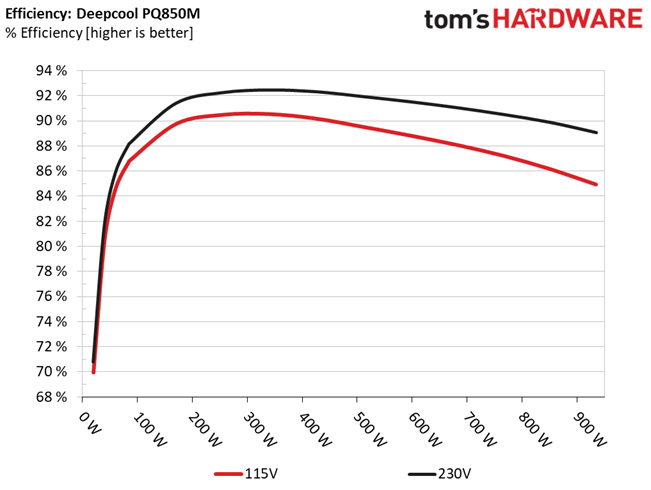

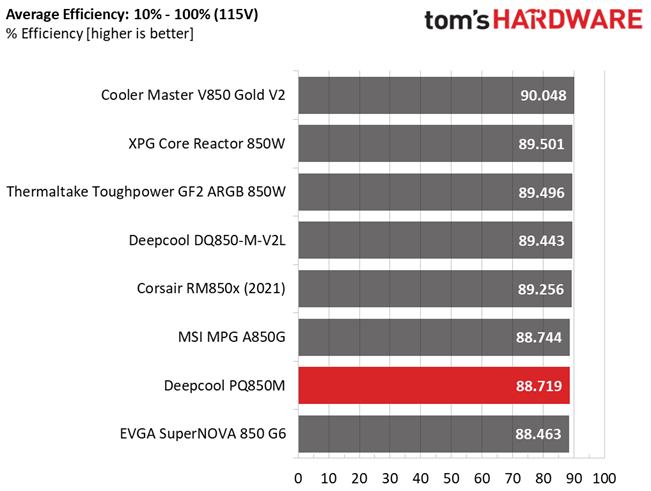



With normal loads, the competition is ahead. With 20-80W loads, the PQ850M performs better. Finally, with a 2% load, it cannot reach 70% efficiency, which is not a problem for the EVGA 850 G6, which uses a more advanced version of the Focus platform.
5VSB Efficiency
| Test # | 5VSB | DC/AC (Watts) | Efficiency | PF/AC Volts |
| 1 | 0.1A | 0.513W | 74.635% | 0.107 |
| Row 2 - Cell 0 | 5.125V | 0.687W | Row 2 - Cell 3 | 115.11V |
| 2 | 0.25A | 1.281W | 77.404% | 0.219 |
| Row 4 - Cell 0 | 5.121V | 1.655W | Row 4 - Cell 3 | 115.11V |
| 3 | 0.55A | 2.813W | 78.395% | 0.334 |
| Row 6 - Cell 0 | 5.114V | 3.588W | Row 6 - Cell 3 | 115.11V |
| 4 | 1A | 5.105W | 78.324% | 0.405 |
| Row 8 - Cell 0 | 5.104V | 6.518W | Row 8 - Cell 3 | 115.11V |
| 5 | 1.5A | 7.64W | 78.283% | 0.442 |
| Row 10 - Cell 0 | 5.093V | 9.759W | Row 10 - Cell 3 | 115.11V |
| 6 | 3A | 15.155W | 76.86% | 0.489 |
| Row 12 - Cell 0 | 5.051V | 19.717W | Row 12 - Cell 3 | 115.11V |
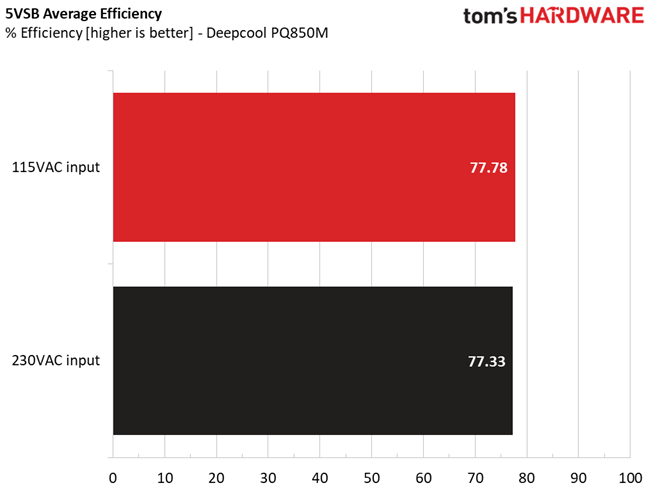

We would like to see over 79% average efficiency at 5VSB.
Power Consumption In Idle And Standby
| Mode | 12V | 5V | 3.3V | 5VSB | Watts | PF/AC Volts |
| Idle | 12.095V | 5.041V | 3.33V | 5.127V | 7.761 | 0.505 |
| Row 2 - Cell 0 | Row 2 - Cell 1 | Row 2 - Cell 2 | Row 2 - Cell 3 | Row 2 - Cell 4 | Row 2 - Cell 5 | 115.11V |
| Standby | Row 3 - Cell 1 | Row 3 - Cell 2 | Row 3 - Cell 3 | Row 3 - Cell 4 | 0.043 | 0.007 |
| Row 4 - Cell 0 | Row 4 - Cell 1 | Row 4 - Cell 2 | Row 4 - Cell 3 | Row 4 - Cell 4 | Row 4 - Cell 5 | 115.11V |

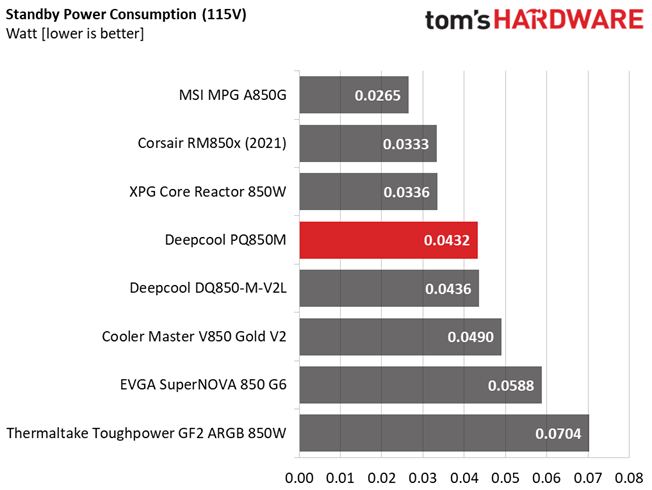
Vampire power is low.
Fan RPM, Delta Temperature, And Output Noise
All results are obtained between an ambient temperature of 37 to 47 degrees Celsius (98.6 to 116.6 degrees Fahrenheit).
The fan speed profile pushes the small fan to its limits, under high operating conditions.
The following results were obtained at 30 to 32 degrees Celsius (86 to 89.6 degrees Fahrenheit) ambient temperature.
At normal operating temperatures, close to 30 degrees Celsius, the PSU is silent with up to 620W loads. It exceeds 30 dBA with more than 690W, and it enters the 35-40 dBA zone with more than 750W at 12V. All in all, this is not a noisy PSU.
MORE: Best Power Supplies
MORE: How We Test Power Supplies
MORE: All Power Supply Content
Current page: Load Regulation, Hold-Up Time, Inrush & Leakage Current, Efficiency and Noise
Prev Page Specifications and Part Analysis Next Page Protection Features, DC Power Sequencing, Cross-Load Tests and Infrared Images
Aris Mpitziopoulos is a contributing editor at Tom's Hardware, covering PSUs.
-
Co BIY This category seems to show all the competitors neck-and-neck. Are they all using the SeaSonic Gold Platform ?Reply
I don't mind the grid pattern and perhaps it's excellent airflow allowed for less fan.
I think it looks particularly sharp on the back. -
drajitsh It is not ideal to buy a PSU right now because we are in a transition phase from the previous ATX spec to the new one. I am likely going to be forced to buy 2 systems for my office. They will have integrated graphics to start with and will be upgraded to low end discrete graphics in 1-2 years. Does your recommendation still stand?Reply -
Co BIY Replydrajitsh said:It is not ideal to buy a PSU right now because we are in a transition phase from the previous ATX spec to the new one. I am likely going to be forced to buy 2 systems for my office. They will have integrated graphics to start with and will be upgraded to low end discrete graphics in 1-2 years. Does your recommendation still stand?
I don't think low end cards will be requiring the new connectors in the short term. This is a necessity only for the high end cards with crazy peak power draws.
The makers of the low end cards will also build them to match the likely customer , you and the other 500 million people running machines without the ATX3.0 PSU upgrades.
Question: Why are PSU's built with fan grills ? None of the other fans in PCs have grills and PSU fans aren't bigger or faster . Also readily replaceable fans could be a great selling point because users want to mod. -
Co BIY ReplyTom Sunday said:The old story...eveyone wants a piece of the pie! Deepcool once dedicated exclusively for PC cooling now into PSU's as well. Next we have Seasonic making memory. I wish that companies would perfect their originally intended product line and giving us those results, instead of just plastering their nane on products made by others. I have no respect for this as it is a quick fix to make more money and even having some people believe that they have a better product when this is absolutely not the case .
I agree with you if they just slap their "Premium" name and a few RGB's to something of below average quality and then throw it out there at a Premium price.
In this case they started with a very solid platform, executed it competently and it delivers the goods quietly.
This PSU doesn't seem like it's worth getting the pitchforks out for. -
Co BIY ReplyTom Sunday said:Yes you are on the point as always!
Thank You for the compliment!
Tom Sunday said:My other 'Deepcool' thought and great hope was that someday perhaps air-cooling products will equal the thermal performance of AIO’s. In part many users even with extensive experience sometimes have trouble installing AIO’s into their case.
I agree with you that the simplicity, reliability and cost advantages of air cooling justify continued development. Lenovo has an interesting offset stacked air cooler design on their new Threadripper workstations that I would like to see make it to the DIY market .
Lenovo Thinkstation P620 Review (at Anandtech)
